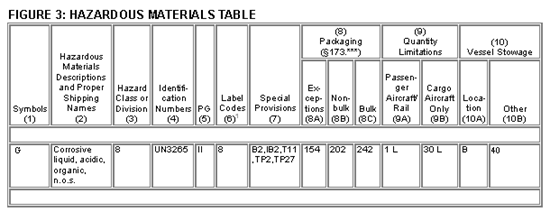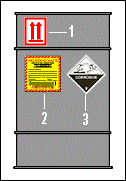Steps for Safe Hazmat Shipping
The U.S.
The U.S. Department of Transportation (DOT) requires shippers to complete the appropriate shipping papers in a standardized format, attach DOT markings and labels to the packaging, and affix markings and placards on the transport vehicle. The intent of these requirements is to protect the public and the environment from the hazards of these materials during transportation.
Shippers can ensure the safe transportation of hazardous materials by following the six steps listed in Fig. 1. Let's follow these steps in an example. Acme Plating Company generates a liquid waste, which it disposes at the rate of six drums every three months. The material is primarily organic with various residues, but has enough Phosphoric acid to make it corrosive. The environmental manager classified the material as a hazardous waste with an EPA waste code of D002 (for corrosivity).
Featured Content
Step 1 Classification
DOT divides hazardous materials (HM) into nine main hazard classes. Classification involves determining whether the material meets any of the DOT hazard classes specified in the HM Regulations (49 CFR Parts 171 - 180), and, if it does, selecting the Proper Shipping Name (PSN). The HM Table (Section 172.101) is used to select the PSN and determine the Basic Shipping Description. Sections 172.200 through 172.205 explain how the Basic Shipping Description must appear on the shipping paper, and under what circumstances it is necessary to supplement the basic description.
|
FIGURE 1: STEPS TO SAFE SHIPPING
|
|
| 1. Classification--shipping description 2. Packaging--selection and assembly 3. Marking of packages 4. Labeling of packages 5. Shipping papers & emergency response info 6. Placarding and marking of vehicles |
|
In our example, the material is a mixture regulated as a hazardous waste under the RCRA rules. Its transportation is also regulated by DOT under the HM regs. The material is not listed by name in the HM Table (we didn't expect it). Phosphoric Acid, a constituent, is listed, but the material is substantially different. To classify the material, we reviewed its properties against the criteria for the DOT hazard criteria (see Fig. 2), we determined that it meets the criteria of Class 8 (Corrosive) and we assigned it to Packing Group (PG) II. The material did not meet any other hazard criteria.
Then, we turned to the HM Table and we selected "Corrosive liquid, acidic, organic, n.o.s." as an appropriate PSN. This entry (see Fig. 3) gives us lots of useful shipping information. The Basic Shipping Description for a material consists of the following in exact sequence: the PSN prescribed in Column 2 of HM Table, the Hazard Class or Division prescribed in Column 3, the identification number prescribed in Column 4, and the Packing Group in Roman numerals prescribed in Column 5 preceded by the letters "PG", if applicable. For our example, that is: "Corrosive liquid, acidic, organic, n.o.s., 8, UN3265, PG II."
|
FIGURE 2: DOT HAZARD CLASSIFICATION
|
|
|
-- |
Forbidden materials, forbidden explosives 173.50: Explosives 173.115: Flammable gases, non-flammable compressed gases, poisonous gases 173.120: Flammable liquid, Combustible liquid 173.124: Other flammable materials. 173.27 & 128: Oxidizers 173.132 & 173.134: Poison, infectious substances 173.403: Radioactive materials 173.136: Corrosive materials 173.140: Miscellaneous hazardous materials ORM-D, Consumer commodity (173.144), elevated temperature (171.8) |
Next, we determined what additional description we needed to include with the Basic Shipping Description. Because the PSN is a generic name ("G" in Column 1), we included the technical name of the constituent that contributed the hazards. Phosphoric acid is what makes the material corrosive. Because the material is a waste, we needed to add "waste."
If the material or any of its constituents are listed in Appendix A, the list of hazardous substances and the quantity present in the container equals or exceeds its Reportable Quantity, we must add "RQ" to the shipping description. If the name of the hazardous substance is different from the PSN, we must include the technical name of the hazardous substance.
For our example, each drum weighs about 300 lb. Our material is not listed by name in Appendix A. Phosphoric acid is listed with an RQ of 5,000 lb--the amount in the drum does not exceed this RQ. EPA waste code D002 is listed with an RQ of 100 pounds-- the amount of the material assigned this code (300 pounds) exceeds this RQ. As result, we added additional description for this hazardous substance.
We also checked the list of Marine Pollutants and other requirements. No other additional description was required. The complete shipping description is: "Waste corrosive liquid, acidic, organic, n.o.s. (Phosphoric Acid), 8, UN3265, PG II, RQ (D002)."
Step 2 Packaging
An HM must be offered for transportation only in authorized packaging. United Nations (UN) performance packaging is used for HM packaged for non-bulk shipments, unless excepted. The manufacturer must mark with appropriate UN marking on each package represented as meeting UN performance standards. Containers of less than 119 gal are considered non-bulk.
The hazardous waste regulations limit accumulation of the waste to 55 gal per container. We decided to use 55-gal drums to both accumulate and dispose of the waste. For increased safety, we wanted metallic drums. The waste vendor recommended steel drums marked UN 1A1/X 1.8 /250. 1A1 is the code for non-removable head, steel drums. X means it meets performance level for Packing Group I, the highest level.
Column 8 of the HM table entry referred us to 173.202. This section lists 1A1 type drum as an authorized type of container. We can use the suggested type of drum because it is authorized and its performance level is even better than PG II level.
Step 3 Marking of packages
The RCRA hazardous waste regulations require that a container of 110 gal or less capacity that contains a hazardous waste be marked with the following information:
"HAZARDOUS WASTE -- Federal Law Prohibits Improper Disposal. If found, contact the nearest police or public safety authority or the U.S. Environmental Protection Agency.
Generator's Name and Address _____.
Manifest Document Number ______."
Some state-run RCRA programs require a variation of this notice. Because hazardous waste is also regulated under the DOT regulations, when in transport, the container must also display the appropriate DOT markings and labels.
The HM regulations require that a non-bulk (< 119 gal) hazmat package be marked with the material's PSN, identification number, and name and address of the consignor or consignee. Additional markings may be required depending on the material and shipment. Examples of these markings include the ISO orientation arrows for liquids in combination packaging, and "RQ" with the PSN for hazardous substances and "waste" for hazardous waste.
Most shippers consolidate the markings in what is commonly referred to as a "hazardous waste label" affixed to containers.
For our example, in order to eliminate errors, we chose to use pre-printed hazardous waste labels thathich include all EPA/DOT markings and space to add contents/shipment specific information at the time of the shipment. We affix the hazardous waste label to the empty container when we are ready to start accumulating the waste.
Step 4 Labeling of Packages
A hazmat package must bear DOT labels to provide visual warning about the material's hazards. DOT labels are 100 mm X 100mm square on point labels. Their design is federally regulated. Each DOT label corresponds to a DOT Hazard Class or Division Number. The label must be visible and near the DOT markings.
For our example, we need a Corrosive label according to he label code in Column 6 of the HM Table. We affix the label to the empty container at the same time we affix the "hazardous waste" label. We then use the empty container to accumulate the waste. When the drum is full of waste, we add the accumulation date and move the container in the temporary storage area.
Step 5 Shipping Paper and Emergency Response Information
When offering an HM for transportation, the material must be described in a shipping paper as required by HM regulations. The travels with the shipment in order to provide a complete and accurate record of the materials and their hazards. The information on the shipping paper must be legible, in English and meet the requirements of the HM Regulations. The shipping paper must include for each HM: the shipping description; the total quantity; name of the shipper and address; an emergency contact telephone number clearly identified; consecutive page number of total pages (e.g. Page 1 of 4) if applicable; shipper's certification; and signature. For hazardous waste shipments, the shipper must use the Hazardous Waste Manifest as the shipping paper.
In addition to preparing the shipping paper, the shipper must also provide the transporter with emergency response information for each hazardous material. Because we do not have a material safety data sheet for this material, we decided to use the Emergency Response Guide Book for that purpose. We will include with the manifest a copy of Emergency Response Guide 153, which corresponds to the materials PSN.
Step 6 Placarding & marking
DOT placards are similar to labels, but larger in size (273 mm x 273 mm). Their design is also federally regulated. They are placed on bulk packages and transport vehicles, usually on both sides and ends. Placards provide visual warning of the hazards of the materials in a vehicle or container. The shipper is responsible to offer the placards. For highway transportation, the driver is responsible to affix the placards. Placards are required for some materials regardless of quantity while for other materials only if they exceed 1,000 lb. In certain cases, the material's identification number must be marked on the transport vehicle or the bulk package. The material identification can be on the placards or orange panels.
For our example, the truck driver must affix Corrosive placards to the pick-up truck, because he is loading more than 1,000 lb of corrosive material (1,800 lb in 6 drums). Because the total quantity of the material is not more than 8,820 lb (non-bulk), we do not need to provide the identification number.
When its time to dispose the drums, we prepare the drums and the paperwork and schedule pickup by the carrier. We conduct final inspections and correct any problems before the waste is on its way for disposal.
Shippers of hazmats save lives by being knowledgeable and well trained and preparation the hazmats for safe shipping.
About the author: Prokopis A. Christou, P.E. manages environmental and hazardous materials transportation issues at Formosa Plastics Corp., U.S.A., Livingston, NJ; Tel. (973) 716-7341, fax (973) 716-7283.




















